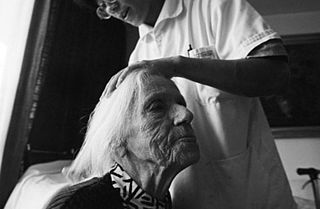
Home care is supportive care provided in the home. Care may be provided by licensed healthcare professionals who provide medical treatment needs or by professional caregivers who provide daily assistance to ensure the activities of daily living (ADLs) are met. In-home medical care is often and more accurately referred to as home health care or formal care. Home health care is different non-medical care, custodial care, or private-duty care which refers to assistance and services provided by persons who are not nurses, doctors, or other licensed medical personnel. For patients recovering from surgery or illness, home care may include rehabilitative therapies. For terminally ill patients, home care may include hospice care.

United Kingdom labour law regulates the relations between workers, employers and trade unions. People at work in the UK can rely upon a minimum set of employment rights, which are found in Acts of Parliament, Regulations, common law and equity. This includes the right to a minimum wage of £9.50 for over-23-year-olds from April 2022 under the National Minimum Wage Act 1998. The Working Time Regulations 1998 give the right to 28 days paid holidays, breaks from work, and attempt to limit long working hours. The Employment Rights Act 1996 gives the right to leave for child care, and the right to request flexible working patterns. The Pensions Act 2008 gives the right to be automatically enrolled in a basic occupational pension, whose funds must be protected according to the Pensions Act 1995.

David Murray Hereora was a New Zealand trade unionist and politician. He was a list MP for the Labour Party from 2002 to 2008.

Darien Elizabeth Fenton is a New Zealand politician and was a Member of Parliament from 2005 until her retirement in 2014.
Pregnancy discrimination is a type of employment discrimination that occurs when expectant women are fired, not hired, or otherwise discriminated against due to their pregnancy or intention to become pregnant. Common forms of pregnancy discrimination include not being hired due to visible pregnancy or likelihood of becoming pregnant, being fired after informing an employer of one's pregnancy, being fired after maternity leave, and receiving a pay dock due to pregnancy. Pregnancy discrimination may also take the form of denying reasonable accommodations to workers based on pregnancy, childbirth, and related medical conditions. Pregnancy discrimination has also been examined to have an indirect relationship with the decline of a mother's physical and mental health. Convention on the Elimination of All Forms of Discrimination against Women prohibits dismissal on the grounds of maternity or pregnancy and ensures right to maternity leave or comparable social benefits. The Maternity Protection Convention C 183 proclaims adequate protection for pregnancy as well. Though women have some protection in the United States because of the Pregnancy Discrimination Act of 1978, it has not completely curbed the incidence of pregnancy discrimination. The Equal Rights Amendment could ensure more robust sex equality ensuring that women and men could both work and have children at the same time.

The Court of Appeal of New Zealand is the principal intermediate appellate court of New Zealand. It is also the final appellate court for a number of matters. In practice, most appeals are resolved at this intermediate appellate level, rather than in the Supreme Court. The Court of Appeal has existed as a separate court since 1862 but, until 1957, it was composed of judges of the High Court sitting periodically in panels. In 1957 the Court of Appeal was reconstituted as a permanent court separate from the High Court. It is located in Wellington.
The Transfer of Undertakings Regulations 2006 known colloquially as TUPE and pronounced TU-pee, are the United Kingdom's implementation of the European Union Transfer of Undertakings Directive. It is an important part of UK labour law, protecting employees whose business is being transferred to another business. The 2006 regulations replace the old 1981 regulations which implemented the original Directive. The law has been amended in 2014 and 2018, and various provisions within the 2006 Regulations have altered.

The Service & Food Workers Union Nga Ringa Tota (SFWU) was a trade union in New Zealand. It was affiliated with the New Zealand Council of Trade Unions and the New Zealand Labour Party.

The New Zealand Employment Relations Act 2000 is a statute of the Parliament of New Zealand. It was substantially amended by the Employment Relations Amendment Act 2001 and by the ERAA 2004.
United Kingdom agency worker law refers to the law which regulates people's work through employment agencies in the United Kingdom. Though statistics are disputed, there are currently between half a million and one and a half million agency workers in the UK, and probably over 17,000 agencies. As a result of judge made law and absence of statutory protection, agency workers have more flexible pay and working conditions than permanent staff covered under the Employment Rights Act 1996.

Indian labour law refers to law regulating labour in India. Traditionally, the Indian government at the federal and state levels has sought to ensure a high degree of protection for workers, but in practice, this differs due to the form of government and because labour is a subject in the concurrent list of the Indian Constitution. The Minimum Wages Act 1948 requires companies to pay the minimum wage set by the government alongside limiting working weeks to 40 hours. Overtime is strongly discouraged with the premium on overtime being 100% of the total wage. The Payment of Wages Act 1936 mandates the payment of wages on time on the last working day of every month via bank transfer or postal service. The Factories Act 1948 and the Shops and Establishment Act 1960 mandate 15 working days of fully paid vacation leave each year to each employee with an additional 7 fully paid sick days. The Maternity Benefit (Amendment) Act, 2017 gives female employees of every company the right to take 6 months' worth of fully paid maternity leave. It also provides for 6 weeks worth of paid leaves in case of miscarriage or medical termination of pregnancy. The Employees' Provident Fund Organisation and the Employees' State Insurance, governed by statutory acts provide workers with necessary social security for retirement benefits and medical and unemployment benefits respectively. Workers entitled to be covered under the Employees' State Insurance are also entitled to 90 days worth of paid medical leaves. A contract of employment can always provide for more rights than the statutory minimum set rights. The Indian parliament passed four labour codes in the 2019 and 2020 sessions. These four codes will consolidate 44 existing labour laws. They are: The Industrial Relations Code 2020, The Code on Social Security 2020, The Occupational Safety, Health and Working Conditions Code, 2020 and The Code on Wages 2019.

The Ministry of Business, Innovation and Employment is the public service department of New Zealand charged with "delivering policy, services, advice and regulation" which contribute to New Zealand's economic productivity and business growth.
Labour rights in New Zealand are largely covered by both statute, particularly the Employment Relations Act 2000, and common law. The Ministry of Business, Innovation and Employment carries out most of the day to day administrative functions surrounding labour rights and their practical application in the state.
Harris v. Quinn, 573 U.S. 616 (2014), is a US labor law case of the United States Supreme Court regarding provisions of Illinois state law that allowed a union security agreement. Since the Taft-Hartley Act of 1947 prohibited the closed shop, states could still choose whether to allow unions to collect fees from non-union members since the collective agreements with the employer would still benefit non-union members. The Court decided 5–4 that Illinois's Public Labor Relations Act, which permitted the union security agreements, violated the First Amendment. A similar case was decided by the Court in 2018, Janus v AFSCME, overturning the Court's unanimous decision in Abood v. Detroit Board of Education (1977) which the appeals court had upheld in Harris.

Teitiota v Chief Executive Ministry of Business, Innovation and Employment concerned an application by a Kiribati man, Ioane Teitiota, for leave to appeal against a decision of New Zealand's Immigration and Protection Tribunal that declined to grant him refugee and/or protected person status. Teitiota's case became a cause célèbre for environmentalists and human rights activists as it made its way towards the Supreme Court. Teitiota was declined application for leave to appeal to the Supreme Court in July 2015. In September 2015 Teitiota was placed in police custody and deported back to Kiribati.
The gender pay gap in New Zealand is the difference in the median hourly wages of men and women in New Zealand.In 2020 the gender pay gap is 9.5%. It is an economic indicator used to measure pay equality. The gender pay gap is an official statistic published annually by Stats NZ sourced from the Household Labour Force Survey.

Taylor v Attorney-General[2015] NZHC 1706 is a New Zealand High Court judgment which made a formal declaration that a statute that prohibited prisoners from voting is inconsistent with the New Zealand Bill of Rights Act 1990. The action was brought by Arthur Taylor, a high-profile prison inmate. This was the first time a court had recognised that a formal declaration of inconsistency is an available remedy for statutory breaches of the Bill of Rights. Section 5 of the Bill of Rights Act states, "Subject to section 4, the rights and freedoms contained in this Bill of Rights may be subject only to such reasonable limits prescribed by law as can be demonstrably justified in a free and democratic society." In his decision, Justice Heath declared that the Electoral Amendment Act 2010 which stripped all voting rights in general elections from prisoners was an unjustified limitation on the right to vote contained in s 12 of the Bill of Rights. The Court of Appeal upheld this decision after the Attorney-General appealed the jurisdiction of the courts to make declarations of inconsistency.

Kristine Robyn Bartlett is an aged care worker from Lower Hutt, New Zealand.
Elizabeth Welch Orr was a New Zealand lecturer and a previous Chancellor of Victoria University of Wellington. Orr was also a trade union leader and advocate for pay equity.










